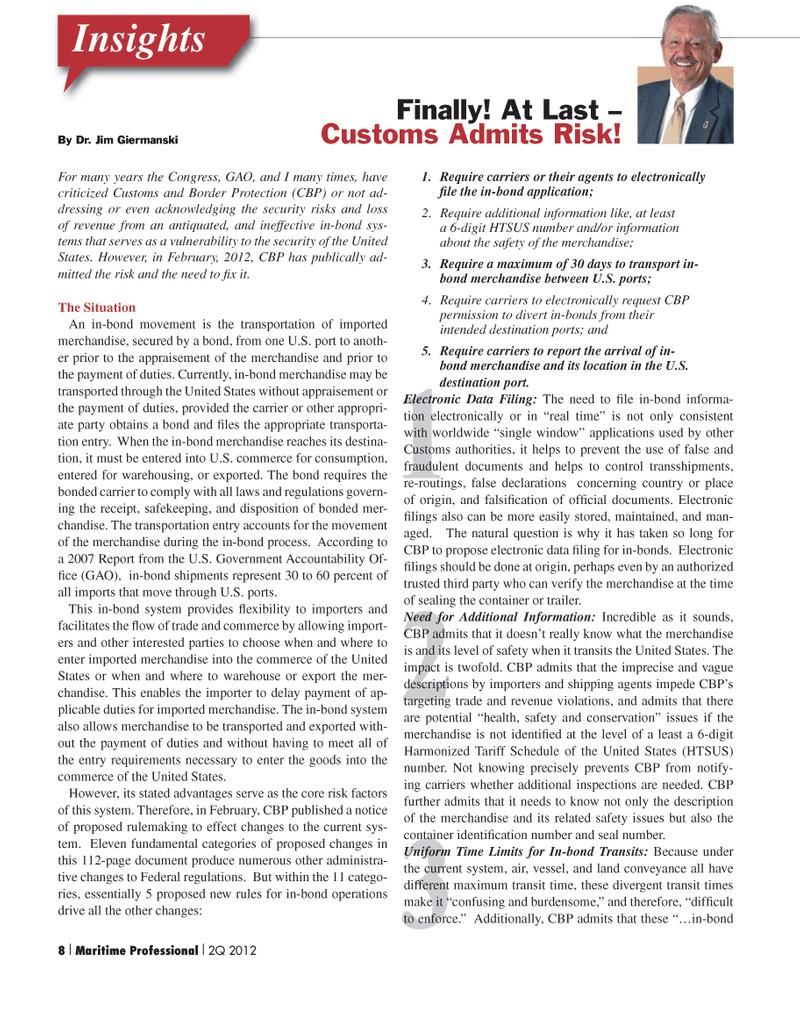
Page 8: of Maritime Logistics Professional Magazine (Q2 2012)
Maritime Risk
Read this page in Pdf, Flash or Html5 edition of Q2 2012 Maritime Logistics Professional Magazine
1 2 3
For many years the Congress, GAO, and I many times, have criticized Customs and Border Protection (CBP) or not ad- dressing or even acknowledging the security risks and loss of revenue from an antiquated, and ineffective in-bond sys- tems that serves as a vulnerability to the security of the United
States. However, in February, 2012, CBP has publically ad- mitted the risk and the need to fi x it.
The Situation
An in-bond movement is the transportation of imported merchandise, secured by a bond, from one U.S. port to anoth- er prior to the appraisement of the merchandise and prior to the payment of duties. Currently, in-bond merchandise may be transported through the United States without appraisement or the payment of duties, provided the carrier or other appropri- ate party obtains a bond and fi les the appropriate transporta- tion entry. When the in-bond merchandise reaches its destina- tion, it must be entered into U.S. commerce for consumption, entered for warehousing, or exported. The bond requires the bonded carrier to comply with all laws and regulations govern- ing the receipt, safekeeping, and disposition of bonded mer- chandise. The transportation entry accounts for the movement of the merchandise during the in-bond process. According to a 2007 Report from the U.S. Government Accountability Of- fi ce (GAO), in-bond shipments represent 30 to 60 percent of all imports that move through U.S. ports.
This in-bond system provides fl exibility to importers and facilitates the fl ow of trade and commerce by allowing import- ers and other interested parties to choose when and where to enter imported merchandise into the commerce of the United
States or when and where to warehouse or export the mer- chandise. This enables the importer to delay payment of ap- plicable duties for imported merchandise. The in-bond system also allows merchandise to be transported and exported with- out the payment of duties and without having to meet all of the entry requirements necessary to enter the goods into the commerce of the United States.
However, its stated advantages serve as the core risk factors of this system. Therefore, in February, CBP published a notice of proposed rulemaking to effect changes to the current sys- tem. Eleven fundamental categories of proposed changes in this 112-page document produce numerous other administra- tive changes to Federal regulations. But within the 11 catego- ries, essentially 5 proposed new rules for in-bond operations drive all the other changes: 1. Require carriers or their agents to electronically fi le the in-bond application; 2. Require additional information like, at least a 6-digit HTSUS number and/or information about the safety of the merchandise; 3. Require a maximum of 30 days to transport in- bond merchandise between U.S. ports; 4. Require carriers to electronically request CBP permission to divert in-bonds from their intended destination ports; and 5. Require carriers to report the arrival of in- bond merchandise and its location in the U.S. destination port.
Electronic Data Filing: The need to fi le in-bond informa- tion electronically or in “real time” is not only consistent with worldwide “single window” applications used by other
Customs authorities, it helps to prevent the use of false and fraudulent documents and helps to control transshipments, re-routings, false declarations concerning country or place of origin, and falsifi cation of offi cial documents. Electronic fi lings also can be more easily stored, maintained, and man- aged. The natural question is why it has taken so long for
CBP to propose electronic data fi ling for in-bonds. Electronic fi lings should be done at origin, perhaps even by an authorized trusted third party who can verify the merchandise at the time of sealing the container or trailer.
Need for Additional Information: Incredible as it sounds,
CBP admits that it doesn’t really know what the merchandise is and its level of safety when it transits the United States. The impact is twofold. CBP admits that the imprecise and vague descriptions by importers and shipping agents impede CBP’s targeting trade and revenue violations, and admits that there are potential “health, safety and conservation” issues if the merchandise is not identifi ed at the level of a least a 6-digit
Harmonized Tariff Schedule of the United States (HTSUS) number. Not knowing precisely prevents CBP from notify- ing carriers whether additional inspections are needed. CBP further admits that it needs to know not only the description of the merchandise and its related safety issues but also the container identifi cation number and seal number.
Uniform Time Limits for In-bond Transits: Because under the current system, air, vessel, and land conveyance all have different maximum transit time, these divergent transit times make it “confusing and burdensome,” and therefore, “diffi cult to enforce.” Additionally, CBP admits that these “…in-bond Finally! At Last –
Customs Admits Risk!By Dr. Jim Giermanski
Insights 8 I Maritime Professional I 2Q 2012
MP #2 1-17NEW STYLES.indd 8 5/4/2012 4:51:09 PM

 7
7

 9
9
